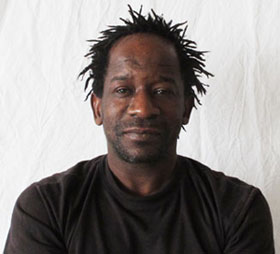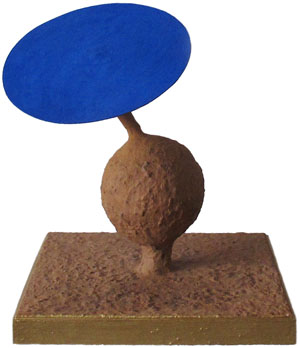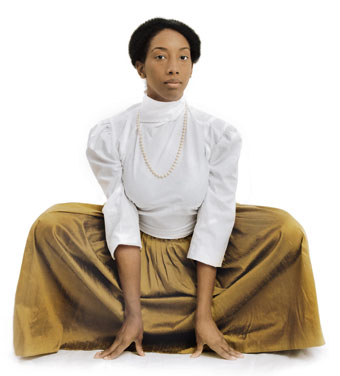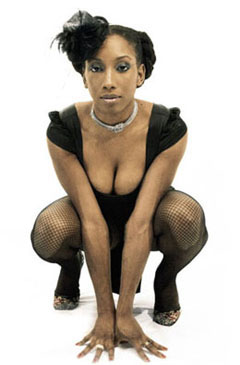Galerie Peter Herrmann |
| Solo-Exhibition |
| Aboudramane - Best of | Solo Show in the Large Exhibition Room |
 |
Opening: Saturday July 23, 2011 Music: Exhibition: Juil, 24. - August 27, 2011 |
|
For 17 years now, the gallery has been working closely with Paris-based artist Aboudramane. After showing his work in many group exhibitions, we are now pleased to present his third solo show, which bears several markings of a full-blown retrospective. |
Aboudramane’s career as an professional artist began in 1990 with a series of architectural maquettes in whose high-quality craftsmanship could be seen the traces of the artist’s carpentry training. In these and later pieces, Aboudramane blends fragments of local West African architecture with western styles and endows the mixture with highly personalized content. Formally, he plays with double meanings, includes puns in his titles and, using appliqué objects from a traditional West African context, evokes the world of healers. These juxtapositions made Aboudramane a highly sought-after artist when it came to curating the content of architecture and secured him a show at New York’s Museum of African Art in the early 1990s. Even more integral to his growing recognition was the way in which the content of his works fit so nicely into the discourse on Africa’s triple heritage, which he expanded like no other visual artist. Twenty years ago, this discourse about how Africa would develop and how the continent would overcome the difficult balancing act between Islam, Christianity and animism – as the old sub-Saharan traditions were then called – was very current. Aboudramane’s work explored those questions subtly, bitingly and humorously. Influenced by his family heritage, the master combined forms and icons from his African background with those from his European present. Aboudramane’s family originally came from Muslim Mali; the artist himself was raised in Christian-dominated Abidjan; and his thinking was heavily influenced by his grandfather, a traditional healer. |
Aboudramane was one of the few artists present in Germany during the first surge of interest in African artists in 1995, and he was included in virtually every publication released at the time. As one of the first African artists to show at an international fair, he was represented at Art Cologne by Galerie Dany Keller. He quickly gained fame in Belgium, the Netherlands, Spain, France and the United States, and his works were sold to important collections. Like many artists from African countries, he gained his fame and success in Europe and the United States, not Africa. All the more gratifying for Aboudramane, then, to be featured in the 1995 Around and Around exhibition curated by Achim Kubinski and Peter Herrmann in cooperation with DoualArt and thereby have his work shown in Cameroon, at one of four stations spread across. Today, it’s hard to imagine that he was one of the African artists – together with Chéri Samba and Sokari Douglas Camp – whose well-known name pulled completely unknown talents like Pascale Marthine Tayou and Owusu-Ankomah into the limelight they currently occupy. |
 |
In the 1990s, the largest exhibition in Germany featuring artists from Africa was the 7th Triennial of Small Sculptures Europa-Afrika in Stuttgart; Aboudramane was one of 40 African artists selected to show in the exhibition. Almost all the artists included – 25 of whom were chosen on Peter Herrmann’s suggestion – now have an international presence. Twelve museums and ten galleries came together around the topic of non-European art and set an important benchmark with their Multiple Echo concept Vielfaches Echo. Along with an impressive number of museum exhibitions, Aboudramane was also included in Galerie Ochs Berlin/Beijing’s Rest of the World Der Rest der Welt exhibition alongside a world-class selection of artists. The current exhibition at Galerie Herrmann will feature architectural sculptures and steles. The surfaces will be especially interesting to those who notice and love sophisticated details, adorned as they are with everything the city and nature has to offer: eggs, bones, shells, grass, horns, soil. Tennis racquets, beads and fencing masks. There’s no material Aboudramane won’t use – leather, clay, acrylic, feathers, metal sheets, rubber, textiles, glass and fur. Materials and meanings open up layer by layer. The depth is nearly impenetrable. Peter Herrmann. July 2011 |
| Accrochage |
| Ayana V. Jackson - Leapfrog-The Grand Matron Series | In the Vestibule |
Opening: Accrochage: |
 |
|
Our cooperation with African American artist Ayana V. Jackson began in 2005, when Jackson spent some time in Berlin studying with Katharina Sieverding at the University of the Arts. That year, we included her photographic research on hip-hop, Full Circle Series 1, in our Visualized Rhythms – Music in African Visual Art exhibition. Since her 2008 solo show, Looking Glass Self, she’s become a well-known fixture in the gallery program. Since that first show, we’ve shown Jackson’s work in various group exhibitions, most recently at Focus 11 in Basel. |
The African American artist, who currently lives in Johannesburg, plunged into the world of African art and artists while conducting sociological photographic research. But at the latest since participating in the Photography Biennial in Bamako, she’s become an integral element of the new continental caravan. If at the beginning Jackson’s work still retained a distinctly documentary character, it has evolved steadily since the Black Madonna series as the artist moves more and more towards photographic staging – as, for example, in the new Leapfrog series that we’re now exhibiting. The work consists of a series of photographs along with a video, which we will present to you in our upcoming Video Weeks. The photographs trace, in ten stages, the evolution story of the African woman since pre-colonial times and jump chronologically from one generation to the next. Inspired by the self-portraits of Claude Cahun and Samuel Fosso, Jackson uses herself as the model, who carries within her a little piece of all the time periods represented in the work – "a bit of the other." The artist portrays archetypes in the pictures, beginning in a traditional African context then moving more and more towards the diaspora and landing, eventually, in the globalized modern era. Dressed in the fashions of the respective epochs, she presents herself in colonial times and in the Enlightenment, as part of the abolitionist movement, the African independence movement, the civil rights movement and the Harlem Renaissance, arriving, at last, at the post-black and afrofuturist present. Taken together, the images constitute the Grand Matron Army, which represents the principle of memory. |
 |
The leapfrog arrangement references several mythologies, particularly those related to fertility, while also fcuntioning metaphorically. The kinetic aspect of the stance – i.e. the impending jump – calls to mind a mother’s commitment to seeing beyond barriers in an effort to seek opportunities for the next generation. At the same time, the position brings sexuality into the matter and asks the viewer to question the role of desire and objectification in class mobility. The work was produced in consideration of the scholarship of Paul Gilroy and Stuart Hall and inspired by photographers Katherina Sieverding, Samuel Fosso and Claude Cahun. Production was made possible with the help of Natacha Bernette (makeup artist), Tamara Faniot (stylist), Sarah Bernstien (photographer), Andreas Vlachakis (photographer), David Tlale (designer) and Feisel D (makeup artist and stylist). The video was produced in collaboration with the artist Pascale Obolo. Peter Herrmann. Juli 2011 |
|
more about the artist at our domain |
||
Homepage: The Leapfrog series |
Dia-Show |
Photos of the new gallery space >> |
Galerie Peter Herrmann |
For 22 years, Galerie Peter Herrmann has provided artists with African roots a platform through which to build a global network. Trade show appearances and international collaborations along with five or six annual exhibitions in Berlin provide a cross-cultural context in which to discuss their multimedia works. As curator, Peter Herrmann has organized more than 300 exhibitions – in his own gallery space as well as in museums and at art associations – and has taken an active stand on cultural policy issues. info@galerie-herrmann.com |
In case you don't want to get this newsletter any more, please send delete from the list |